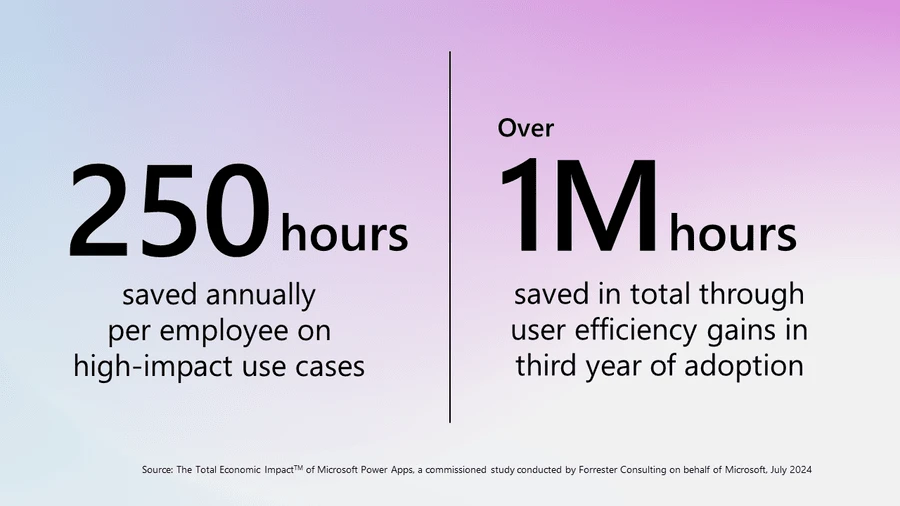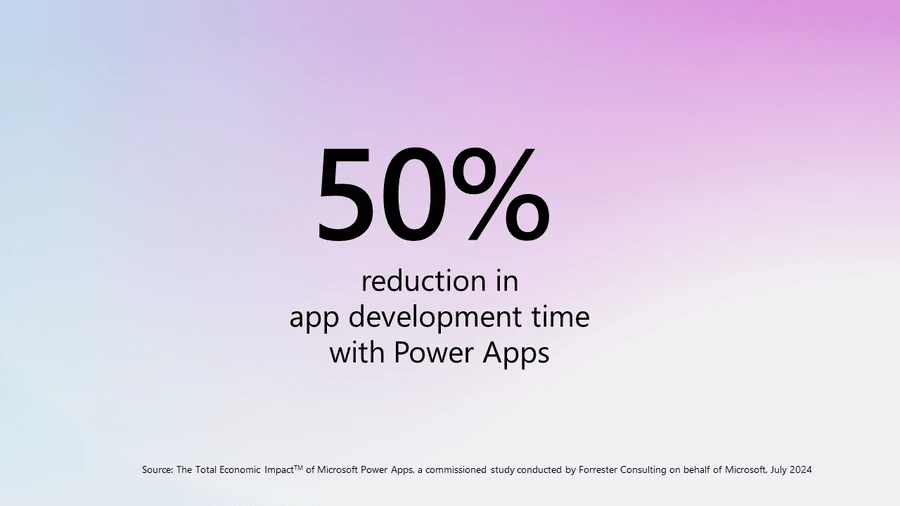
Millions of hours saved, 50% faster app development, and 206% ROI achieved with Microsoft Power Apps Premium
Every month, 25 million users benefit from the solutions built with Microsoft Power Apps, a leading platform to build modern, intelligent, and high-performance applications.¹ To help customers better understand the overall business value of Power Apps Premium, Microsoft commissioned an independent study by Forrester Consulting, titled the Total Economic ImpactTM of Power Apps.
Forrester interviewed 13 representatives of organizations that have invested in Power Apps Premium as well as other components of the Power Platform and aggregated their experiences into a composite organization with 30,000 employees, $10 billion in annual revenue, 200 professional developers, and 1,800 citizen developers. They modeled gradual adoption of Power Apps Premium, beginning with 22% licensed employees in the first year and expanding to 66% by the third year.

The Total Economic Impactᵀᴹ of Power Apps
Understand employee efficiency gains, developer productivity improvements, and overall business value that organizations experienced when they adopted Microsoft Power Apps Premium.
The impact of Power Apps Premium on the organization was significant:
- Users saved 250 hours per person on high-impact use-cases. In year three of adoption, the organization saved more than 1,000,000 hours from cumulative user efficiencies.
- Professional developers saw a 50% reduction in application development time. Additionally, improved governance, reduced shadow IT, and enhanced employee experiences were cited by interviewed customers.
- Forrester estimates that customers recovered their initial investment within just six months. After that, the benefits continued to add up, with the effective cost of each new solution nearing zero due to Power Apps Premium offering unlimited apps per user. This drove a rapid increase in net benefits over three years, culminating in a 206% return on investment (ROI) and $31M in net present value (NPV).
Microsoft Copilot in power apps
Learn moreThese findings haven’t yet considered the significant impact of Microsoft Copilot on employee and developer productivity. Developers using Copilot in Power Apps have a 60% higher success rate in building apps and 70% of users of Microsoft Copilot for Microsoft 365 report increased productivity. Considering these additional benefits, the overall business value can be expected to be even higher.
For now, let’s look closer at the business value of Power Apps Premium reported in the Forrester Total Economic ImpactTM study.

Save a million hours in a year
Power Apps empowers businesses to respond swiftly to evolving needs. With a low-code platform that enables more makers to design and deploy applications, while accelerating the work of professional developers, a wide range of use cases can be addressed in record time. A product owner at an energy organization noted to Forrester, “Power Apps allows for faster application development because end-users don’t waste time waiting for a high-code app to be developed or spend time on inefficient processes.” Many other customers not interviewed for the study—Westpac, Epiq, or Vodafone for example—have shared similar experiences of impactful solutions built in weeks instead of months.

Forrester found that productivity gains on high-impact use-cases saved up to 250 hours per user annually, unlocking as much as 12% of an employee’s time for new, productive work. One interviewee highlighted that processes once taking three to six weeks and requiring 10 full-time employees (FTEs) were reduced to just one hour with only two FTEs, thanks to Power Apps.
Individually, 250 hours is a significant gain—imagine what you could accomplish with six extra work weeks! At the organizational level, this impact scales dramatically: in the third year of Power Apps adoption, the organization saved 1,000,000 hours, generating a financial benefit of $31.3 million.
Outside the Forrester study, many of our customers, including EY, Evergy, and Lerøy Seafood, are witnessing similar productivity improvements enabled by low-code solutions.
Equip developers for greater efficiency and achieve 50% faster app development
Low-code promises faster development—but how much faster, and is it truly worth it?
Forrester’s findings indicate that professional developers cut their application development time by 50% using Power Apps Premium. For an organization with 200 professional developers, this efficiency gain is like adding 100 extra developers to meet demands.

This efficiency boost came from leveraging prebuilt templates, reusable components, and drag-and-drop functionality, in conjunction with traditional code extensibility to quickly build and deploy robust applications. Moreover, as citizen developers independently handled certain business issues, professional developers could focus on more complex and high-value projects for users. Customers also noted that before adopting Power Platform, integrating various apps and services required extensive custom development, while with Power Platform this became easier thanks to simple, interconnected, and easy-to-govern low-code tools.
“If we go four years back, when the first Power Apps appeared, it was very non-IT. So, it’s mostly the business areas and engineers making Power Apps and operating themselves appearing all over the place. Now, IT delivers most of the low-code and no-code solutions.”
—Product owner at an energy organization
Improve governance, reduce risks, and innovate with Power Apps
The impact of Power Apps extends well beyond development speed. Besides significant user efficiencies and development productivity, organizations interviewed by Forrester noted improved governance, reduced shadow IT, and innovation culture as important gains.
“It has allowed us to govern in a way that we deem safe and appropriate for our organization.”
—Director of a services company
At Microsoft we see many organizations—Accenture, Deutsche Bahn, or Zurich Insurance Group as an example—leverage advanced governance and administration tools to streamline and simplify their application development and reduce IT risks. Power Platform empowers their employees to build solutions rapidly within the guardrails of IT, improving developer productivity, and thus minimizes the need for unauthorized tools.
Although not quantified, interviewees also mentioned that Power Apps could potentially save their organizations money by replacing legacy solutions. They noted that Power Apps provides a modern and adaptable platform for creating new applications with similar or improved functionalities. Additionally, its capability to connect to various data sources and integrate with existing systems would facilitate a gradual shift from legacy apps to more flexible modern solutions.
Enable your workforce and unlock maximum value with Power Apps Premium
Businesses who are fast to equip their employees with intelligent solutions, who improve customer service, and streamline internal operations have a strong advantage on the market.
The Forrester Total Economic ImpactTM study clearly outlines how adopting Power Apps Premium leads to fast value for business—substantial cost savings, enhanced developer productivity, and a significant overall return on investment.
Read the complete Forrester’s Total Economic ImpactTM study of Power Apps for detailed insights, cost and benefits breakdown, or reach out to your Microsoft contact to build your own business value assessment.
1. Microsoft Fiscal Year 2024 Third Quarter Earnings Conference Call, April 25, 2024
